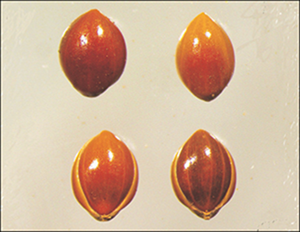Article contents
Did crops expand in tandem with culinary practices from their region of origin? Evidence from ancient DNA and material culture
Published online by Cambridge University Press: 15 January 2024
Abstract

Grain-cooking traditions in Neolithic China have been characterised as a ‘wet’ cuisine based on the boiling and steaming of sticky varieties of cereal. One of these, broomcorn millet, was one of the earliest Chinese crops to move westward into Central Asia and beyond, into regions where grains were typically prepared by grinding and baking. Here, the authors present the genotypes and reconstructed phenotypes of 13 desiccated broomcorn millet samples from Xinjiang (1700 BC–AD 700). The absence in this area of sticky-starch millet and vessels for boiling and steaming suggests that, as they moved west, East Asian cereal crops were decoupled from traditional cooking practices and were incorporated into local cuisines.
- Type
- Research Article
- Information
- Copyright
- Copyright © The Author(s), 2024. Published by Cambridge University Press on behalf of Antiquity Publications Ltd
References
- 2
- Cited by


